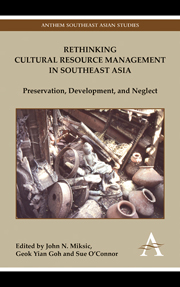Chapter 11 - Using International Heritage Charters in Philippine Cultural Resource Management
from The Philippines
Published online by Cambridge University Press: 05 May 2012
Summary
Introduction
Ronquillo and Dizon, in the National Museum of the Philippines Archaeological Resource Management Manual (1992, 61) write that “In the past decades the rapid rate of commercial development and recent advances in technology has greatly affected the environment, including potential archaeological sites at various levels: regional, national and international.” Indeed, several such incidents of “rapid” development have brought about the need to refl ect on the criteria used to present a recommendation to stop construction work from impacting on an archaeological site. The claim that archaeological sites should not be demolished was repeatedly made during several recently contested infrastructural projects. Why? Because these sites are “heritage” sites and there is no doubt that heritage sites deserve to be conserved, preserved, protected and properly managed. This is, in fact, stipulated in the Philippines National Cultural Property Law, Presidential Decree 374. But, how significant must an archaeological site be to merit a recommendation barring any earth-moving activity or other site disturbance on or around it? How do we decide if it is worthy of preservation, protection and management? Indeed, if we followed the criteria for deciding which sites should be preserved in the legal framework of cultural property laws in the Philippines, a great portion of the country would become unavailable for development.
This chapter will use the Huluga archaeological site in Cagayan de Oro, Northern Mindanao as a case study to evaluate proposed standards for answering these questions.
- Type
- Chapter
- Information
- Rethinking Cultural Resource Management in Southeast AsiaPreservation, Development, and Neglect, pp. 181 - 198Publisher: Anthem PressPrint publication year: 2011



